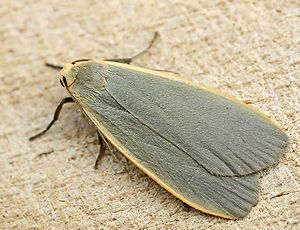Lead-gray lichen bear
| Lead-gray lichen bear | ||||||||||||
|---|---|---|---|---|---|---|---|---|---|---|---|---|

Lead-gray lichen bear ( Eilema griseola ) |
||||||||||||
| Systematics | ||||||||||||
|
||||||||||||
| Scientific name | ||||||||||||
| Eilema griseola | ||||||||||||
| ( Huebner , 1803) |
The lead-gray lichen bear , the lead-gray yellow hem lichen bear or alder lichen bear ( Eilema griseola ) is a butterfly ( moth ) from the subfamily of the bear moth (Arctiinae).
features
The moths reach a wingspan of 29 to 35 mm (males) and 27 to 32 mm (females). In contrast to the other similar lichen bears, the wide forewings have a clearly convex edge. This is yellowish lead-gray in color and has a dull sulfur to brownish-yellow Kostalstripe , which tapers from the middle of the wing leading edge and extends to about the outer third of the forewings. In the rest position, the forewings of this species are laid flat on top of each other ("flat wing type" in contrast to the "rolling wing type" of many other Eilema species). The lighter hind wings are pale yellow-gray in color and have a slightly darker color towards the edge. The hind wings and abdomen are colored yellow on the underside. The short, double-lashed antennae are thread- shaped in both sexes. The species can be confused with the females of the coniferous yellow hem lichen bear ( Eilema deplana ), which however have dark brown-gray hind wings as well as fore wings. The underside of the forewings, like the underside of the thorax, is ash gray, the former have a yellow border. The head, thorax and abdomen are pale ocher yellow on the upper side, the end of the abdomen is a little more vivid yellow.
The caterpillars are black and have two orange-reddish broken back lines. They each have a somewhat thicker spot on the back behind the head capsule and on the end of the abdomen. The animals have numerous shaggy, dark tufts of hair all over their bodies.
Similar species
- Gray-body lichen bear ( Eilema lurideola )
- Yellow lichen bear ( Eilema complana )
- Coniferous Yellow Lichen Bear ( Eilema deplana )
Geographical distribution and habitat
The animals are found all over Europe and in Asia east to Japan . They are absent in the far north of Europe, parts of Great Britain and the Mediterranean region . They live in moist and wet deciduous forests , preferably in swamp and alluvial forests on the plain.
Way of life
The lead-gray lichen bear forms one generation per year, the moths of which fly from late June to late August. The caterpillars can be found from September and after wintering until June of the following year. The caterpillars feed on lichens that grow on deciduous trees. They are mainly found on alder trunks , but they are also found on ash , oak , blackthorn , elm and aspen . The caterpillars live on the trunks at about knee height. They overwinter and pupate only next June in a loose web in cracks in the bark or between lichens.
swell
Individual evidence
- ↑ Manfred Koch : We identify butterflies. Volume 2: Bears, Spinners, Swarmers and Drills in Germany. 2nd, expanded edition. Neumann, Radebeul / Berlin 1964, DNB 452481929 , p. 70f.
literature
- JJ de Freina: The Bombyces and Sphinges of the Western Palaearctic. Volume 1. Noctuoidea, Sphingoidea, Geometoidea, Bombycoidea. EFW Edition Research & Science Verlag GmbH, Munich, 1987, ISBN 3-926285-00-1
- Hans-Josef Weidemann, Jochen Köhler: Moths. Weirdos and hawkers. Naturbuch-Verlag, Augsburg 1996, ISBN 3-89440-128-1 .
Web links
- www.lepiforum.de: Taxonomy and photos
- Moths and Butterflies of Europe and North Africa (English)
- Eilema griseola at Fauna Europaea